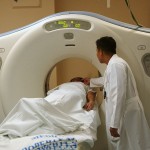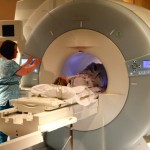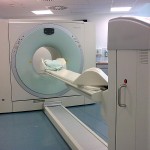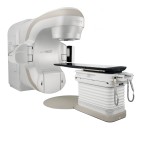What is cancer?
Cancer is a group of diseases involving the unregulated and uncontrollable division of malignant cells in the body, which may further progress into the forming lumps or masses called tumors. Tumors can grow and interfere of the digestive, nervous, and circulatory systems and release hormones that alter body function. Tumors that stay in one spot and show limited growth are generally considered to be benign. Some tumors however, known as malignant tumors may spread through the lymphatic or the circulatory system and affect other sites in the body, a process known as metastasis.
Today, with recent advancements in technology, it has become possible to treat cancers using myriad techniques such as surgery, radiotherapy, chemotherapy and many more. These techniques may be used in combination for some treatment procedures.
What is radiotherapy?
Radiotherapy is a process in which high-energy ionizing radiation is focused at the tumor in order to kill the cancerous cells. Almost half of all people with cancer have radiotherapy included within their treatment plan. Radiotherapy can be classified into two distinct categories
-
External beam Radiotherapy (EBRT)- The radiation is delivered from an external source in this procedure, usually a machine called a linear accelerator, which focuses high energy X-rays onto the tumor site
-
Internal radiotherapy- A small piece of radioactive material is placed temporarily inside the body near the tumor during this procedure, known as brachytherapy. Or a radioactive liquid may be used, which could be swallowed or injected into the body
Radiotherapy may be administered for curative purposes, involving the elimination of the tumor, preventing recurrence, or both. It may also be administered for palliative purposes, which do not intend to eliminate the tumor, but relieve the symptoms that may be experienced as a consequence of cancer. Some examples of palliative radiotherapy involve-
-
Radiation given to the brain to shrink tumors formed because of metastasis
-
Radiation given to diminish a tumor growing within a bone or pressing the spine, which may cause pain
Planning your treatment
Before actual radiation therapy begins, a radiation therapist, under the supervision of a radiation oncologist, plans every step of the patient’s treatment. This is essential in order to maximize the effectiveness of the therapy by ensuring that majority of the dosage is delivered to the tumor itself and minimal damage is done to surrounding healthy tissues. This process is also known as simulation.
During the planning process, the doctor will analyze the results from the diagnosis of the patient and may also carry out additional tests to develop a clearer understanding of the site and size of the tumor and confirm the area of the body to be treated. The simulation process involves the usage of X-ray equipment, Computer Tomography (CT) scanner/Magnetic resonance imaging (MRI) or a Positron Emission Tomography (PET-CT scan) which simulate the actual treatment machine, but without the radiation. This helps obtain pictures of the inside of the body, which are necessary for the treatment team to determine the most suitable position for the patient to be in during the treatment. Following the performance of this CT scan, the radiographer may put small permanent ink marks on the skin of the patient to ensure the treatment area is targeted accurately during every dosage. If it is difficult for the patient to keep the part of the body being treated still, a plastic mould will be made to be worn during treatment. In this case, the ink markings will be made on the mould rather than on your skin.
The type of radiation therapy prescribed by a radiation oncologist depends on many factors, including:
-
The type of cancer
-
The size of the tumor
-
The location of the tumor in the body
-
How close the tumor is with relation to normal tissues that are sensitive to radiation
-
The distance the radiation will have to penetrate inside the body
-
The patient’s general health and medical history
-
Whether the patient will receive any other forms of cancer treatment
Courses of treatment
Radiotherapy is usually conducted as delivering small doses of radiation during individual treatments every day over a number of weeks. Most treatments are carried out daily between Monday and Friday, providing a break during the weekends. The time required for each session varies from machine to machine but will mostly range from five to fifteen minutes. Occasionally, the treatment may take longer and might even be conducted on the weekends. This however will be informed to the patient before treatment in accordance with the treatment plan that has been made. Most patients are treated as outpatients and therefore it may not be required for them to be admitted in the hospital overnight. The radiation oncologist will however recommend the patient if it would be more suitable for him or her to be admitted.
External beam radiotherapy (EBRT)
Many advanced treatment programs have been developed over the years for efficient treatment of cancer. During the procedure of EBRT, the patient has to lie down on a treatment couch and has to be as still as possible in order to allow the radiation to be focused at the targeted region. No pain or sensation will be experienced however during the treatment. The patient can breathe normally throughout the treatment which may last from few to several minutes. A radiographer will operate the machine from outside the room in which the radiation will be delivered and will observe the patient through a window or on a closed circuit television. If necessary, the patient may be able to communicate with the radiographer using an intercom system. The treatment programs include-
IGRT (Image Guided radiotherapy)- This involves the use of imaging techniques such as CT scans, X-ray, and ultrasound to locate the exact position of the tumor in the body and create a three-dimensional image of it and surrounding tissues throughout the course of radiotherapy. This process is conducted before every dosage of radiation to observe changes in the tumor, therefore providing an increased level of precision in targeting the tumor. Some form of imaging is necessary for various tumors as they may be located in organs that are in continuous movement, such as the lungs, thus increasing the possibility of movement of the tumor throughout the therapy routine.
IMRT (Intensity Modulated Radiotherapy)- This is an advanced technique involving the guiding of beams of radiation from different angles to the tumor following three dimensional scans of the tumor. It uses computer technology of multiple beams of radiation of varying intensities at every angle to conform to the shape of the tumor. These adjustments in intensity enable the delivery of suitable dosage of radiation to every part of the tumor, while minimizing damage to surrounding healthy tissue.
Dr. Vivek Bansal is currently using the RapidArc technology made by Varian, an advanced form of IMRT that uses special software and a more sophisticated linear accelerator to deliver treatment about eight times faster than normal IMRT procedures. The RapidArc can deliver the required dosage in only two minutes in a single rotation unlike other machines which have to rotate several times to deliver the required dosage of radiation.
SRS (Stereotactic Radiosurgery) – This technique is mostly used to treat cancers in the brain or the spinal column. It is typically delivered in a maximum of five sessions. Specialised equipment focuses up to 200 small beams of radiation to administer a high dose to the area where the tumor is located, usually in one treatment in a single day. During the procedure, the head of the patient is placed in a frame to keep it still. Although the name includes the word ‘surgery’, it does not involve the physical removal of the tumor, but high-intensity beams of radiation.
SBRT (Stereotactic Body Radiotherapy) - This is a very similar technique to SRS, but is used for targets that are outside the brain and the spine. SBRT is most commonly used for targets in the lung, liver, pancreas and kidney, and is typically delivered in a maximum of five sessions.
A stereotactic radiation treatment for the body means that a specially designed coordinate-system is used to determine the exact location of the tumor in the body in order to treat it with limited but highly precise treatment fields.
FFF technology
Dr. Vivek Bansal is the first in India to use the Flattening Filter-Free (FFF) beam technology of Truebeam in India. It has the advantage of very high dose rates compared to routine linear accelerators thereby providing the benefit of shorter treatment time leading to patient comfort. The increased dose delivery accuracy makes the treatment more sophisticated than routine procedures. Moreover this is used for SRS and SBRT treatments where the total dose is very high usually leading to higher treatment time. However, with FFF, the same procedure can be completed in two to three minutes only which otherwise would take half an hour.
About Truebeam
Truebeam the latest fully Digital LinAc from Varian from USA has a unique advantage that it harnesses the power to deliver all the treatments mentioned previously on the single platform with sub millimetre precision, faster treatment time along with excellent and faster imaging checking facility and well synchronised motion management of the moving target. It is a compltetly new platform which syncs well with treatment planning systems and CT/MRI/PET-CT scanners. It is easy to use and due to the overall new design it is easy to repair faster keeping downtime as low as possible.
Dr Vivek Bansal with his team takes pride in unleashing this equipment for clinical use for the first time at Ahmedabad, India successfully and till date more than 2000 patients have been successfully treated on this equipment.
For more information about Truebeam, visit the url below -
http://www.variantruebeam.com/truebeam-story/introductory-video.html
Internal radiation therapy (Brachytherapy)
Brachytherapy involves the placement of a radioactive substance, known as a radioactive seed inside the body close to the targeted area. The technique has proven to be a strong treatment option for many cancers of the prostate, cervix, endometrium, breast, skin, bronchus, esophagus, and head/neck, as well as soft-tissue sarcomas and several other types of cancer. There are two common methods available to the radiotherapist when administering Brachytherapy: LDR and HDR
Low dose rate (LDR) brachytherapy –
Low strength, sealed radioactive substances, the size of a grain of rice is delivered to the target. These substances are permanently implanted in the body and as they emit radiation, lose strength. In few weeks the amount of radiation emitted cannot be measured
High Dose rate (HDR) brachytherapy –
As opposed to LDR, the radioactive sources are of higher strength. These sources remain in the body temporarily. Treatment is OPD based, faster and the patient can be discharged on the same day. This is basically used to boost the remaining tumor after delivering the maximum dose by LinAc as this has the advantage of saving critical structures surrounding target area due to its rapid fall of property. It can also be used for palliative procedures for symptom relief in advanced cases whereas can occasionally be used as curative procedure in very early cases
Side effects of radiotherapy
It is likely that the patient may experience some side effects after the treatment procedure. The reason for this is that the radiation also damages some of the healthy tissues around the tumor that is targeted. The side effects depend on
-
What area of the body is being treated
-
What dosage of radiation is administered
-
How quickly the healthy cells are able to repair the damages because of radiation
The side effects experienced vary from patient to patient and most of them last for a short period of time during and after the treatment while some may last for much longer periods of time. The side effects can be classified into two distinct categories- generalized side effects and site specific side effects.
Generalized side effects may involve
-
Diarrhea
-
Fatigue
-
Loss of appetite
-
Malaise
-
Nausea and vomiting
-
Hair loss on the part of the body being treated
-
Skin changes, such as sore skin, on the part of the body being treated
- Lymphoedema- Swelling in arms and legs because of accumulation of lymph fluid. This may occur if the patient’s lymph nodes were damaged during radiotherapy
Site specific effects may involve
-
Head and neck cancers (Examples- Oral, tongue and brain)- Inflammation along with dryness in the lining of the oral cavity may occur, which may cause difficulty in swallowing or eating. Inflammation and soreness may also occur in the throat, leading to a sensation of a lump in the throat or burning in the throat or the chest.
-
Brain cancer- Treatment of brain cancer is very likely to involve hair loss on the head. But this can be overcome by reducing the dose to the scalp using IMRT. Headache and blurry vision may also be experienced during or after treatment of brain cancer. Long term side effects may include memory loss and a reduction in cognitive abilities. However, techniques such as hippocampal sparing can help in reducing the loss in memory and cognitive abilities by modern radiotherapy techniques.
-
Prostate cancer- This is a cancer that occurs in males in the prostate gland. If the radiation is not delivered properly, it may lead to swelling of the inner lining of the rectum, a condition called proctitis, consequentially leading to bleeding. It may also result in diarrhea
-
Cancers in the chest- Coughing and a difficulty in breathing may be experienced
-
Pelvis region- Diarrhea and increased frequency and burning during urination is quite common. Proctitis may also occur. If the testes or ovaries are within the field of radiation, it may lead to sterility










